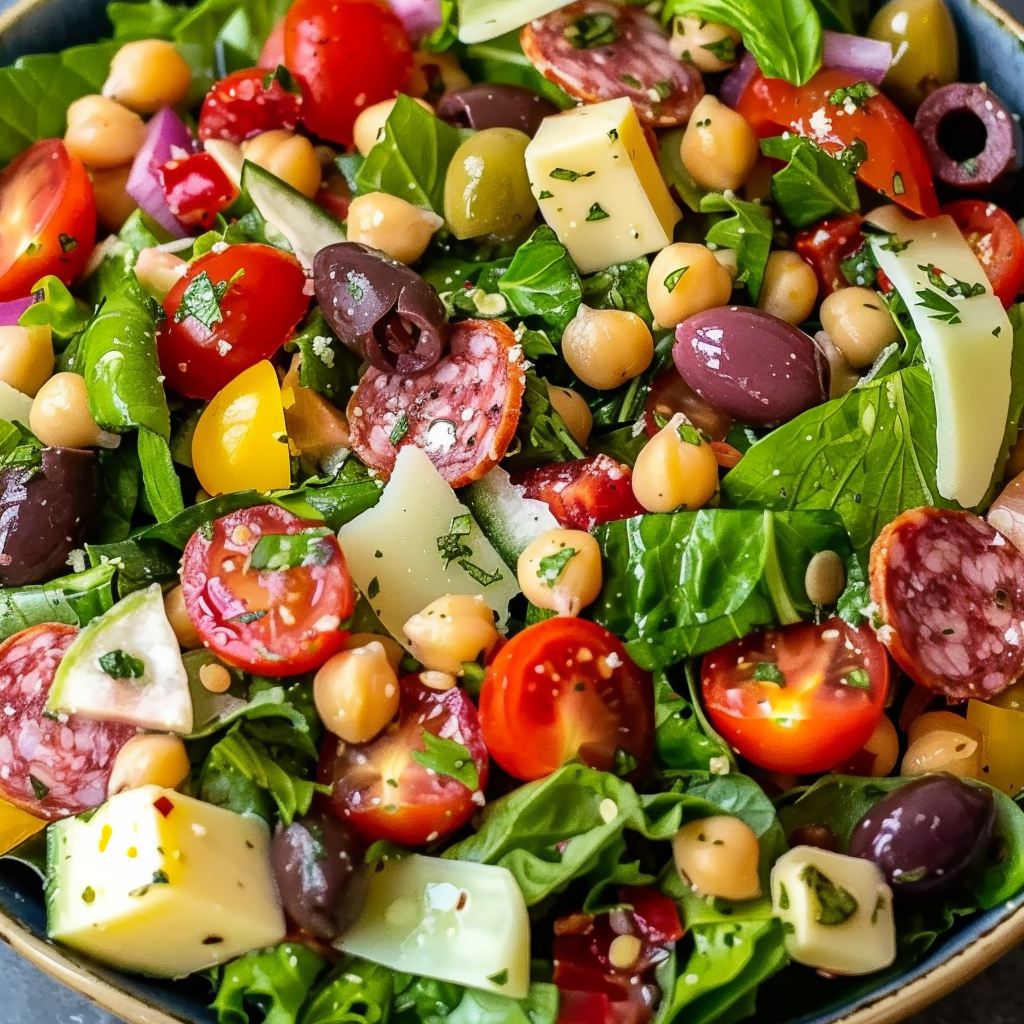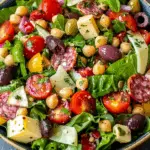Italian Chopped Salads
Italian chopped salads have become a staple in both home kitchens and trendy eateries, offering a crisp, colorful, and flavorful way to enjoy a healthy meal. Unlike traditional tossed salads, chopped salads incorporate a variety of finely cut ingredients, ensuring each bite delivers a perfect balance of taste and texture. This makes them ideal for quick lunches, meal prep, or a light dinner. One of the most popular versions is the Italian chopped salad, known for its zesty flavors and use of Mediterranean-inspired ingredients.
What sets an Italian chopped salad apart is its combination of romaine lettuce, hearty vegetables, olives, cheeses, and protein options like turkey pepperoni or chicken ham. It’s all tied together with a homemade Italian dressing that adds tang and depth. If you’re aiming for both freshness and crunch, romaine is the go-to base. According to Wikipedia, romaine lettuce is not only nutrient-dense but also has a firm texture that holds up well with dressings, unlike more delicate greens.
Incorporating ingredients such as chickpeas, Parmesan cheese, and red wine vinegar adds authenticity and health benefits to this dish. For example, chickpeas are high in plant-based protein and dietary fiber, making them a great addition to a balanced salad. Learn more about their nutritional value on Wikipedia. Meanwhile, the cheeses—particularly mozzarella and Parmesan—provide creamy, savory notes that pair perfectly with the acidic components of the dressing.
Pinterest users searching for Mediterranean diet salad ideas or healthy lunch salad bowls will find that this Italian chopped salad fits seamlessly into both categories. Check out Mediterranean salad bowl ideas for more inspiration or browse healthy lunch salad bowl boards to create your own weekly rotation.
Ultimately, an Italian chopped salad isn’t just a meal—it’s a customizable experience that celebrates bold flavors, vibrant colors, and nutritional balance. Whether you’re new to chopped salads or looking to elevate your lunch game, this guide will walk you through each step of creating your own Italian salad bowl masterpiece.
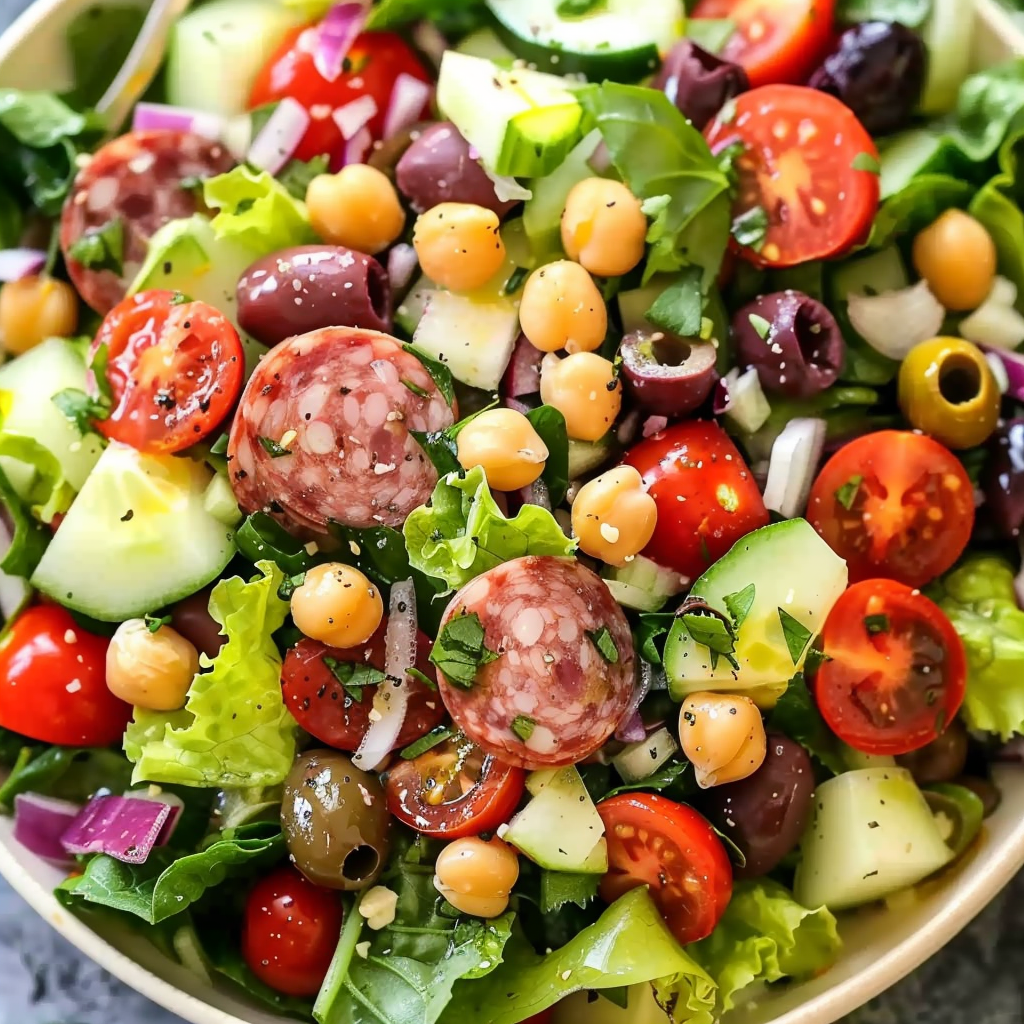
Benefits of Using Romaine in Salads
When it comes to building a crisp, refreshing salad, romaine lettuce stands out as one of the best leafy greens available. Its elongated leaves, sturdy structure, and mild flavor make it a versatile base for chopped salads, especially those inspired by Italian flavors. Beyond its crunch factor, romaine also packs a serious nutritional punch.
One of the most significant advantages of using romaine is its nutrient density. According to Wikipedia, romaine lettuce is rich in vitamin A, vitamin K, and folate, while also being low in calories. This makes it an excellent choice for anyone trying to eat healthier without sacrificing texture or volume in their meals. Additionally, romaine contains dietary fiber, which supports digestive health and helps keep you feeling full longer—key for weight management or clean eating routines.
Another compelling reason to choose romaine is its ability to hold up well against heavier ingredients and homemade dressings. While softer lettuces like butter or baby spinach can wilt quickly, romaine maintains its structure even when coated with oil-based dressings like this Italian vinaigrette made from olive oil, lemon juice, and red wine vinegar. For more information on the dressing base, explore olive oil and red wine vinegar on Wikipedia.
Texture is just as important as taste when creating a satisfying salad. Romaine offers a firm bite that complements chopped ingredients such as cherry tomatoes, shredded carrots, and chickpeas. This ensures that every forkful has a balanced mix of crunch and flavor. If you’re exploring types of lettuce for salad and want a green that performs well across various dishes, romaine is a reliable choice. You can see a detailed comparison of lettuce types on this Wikipedia list.
In terms of flavor pairing, romaine works beautifully with other Italian-inspired components. Its neutral taste allows bolder items—like black olives, roasted red peppers, or Parmesan cheese—to shine. This makes it a foundational element in not only Italian chopped salads but also in chopped salad bowl meal prep routines found on Pinterest. Meal preppers and salad lovers alike favor romaine for its longevity, as it can stay crisp for days when stored properly.
Whether you’re building a healthy lunch salad bowl or a family-sized side dish, romaine provides the structure, nutrition, and mild flavor needed to support bold Mediterranean toppings and zesty dressings. Its adaptability and crunch make it the go-to choice for any chopped salad recipe.
Classic Italian Salad Bowl Ingredients
An Italian chopped salad is more than just lettuce—it’s a medley of flavors, textures, and colors that come together in a bowl to create a satisfying, nutrient-rich dish. At the heart of this recipe is romaine lettuce, but what truly defines the salad is the thoughtful balance of fresh vegetables, salty and creamy additions, and optional proteins that give it substance. Let’s break down the core components that go into building this classic Italian salad bowl.
Base Greens
-
Romaine lettuce (4 cups): Crisp and sturdy, this forms the salad’s foundation. It’s ideal for holding up against the heavier toppings and dressing.
-
Radicchio or red cabbage (2 cups): Adds a pop of color and a slightly bitter contrast to the sweetness of other ingredients.
Fresh Veggies
-
Cherry tomatoes (1 cup): Juicy and sweet, these balance the saltiness of the olives and cheese.
-
Cucumber (½ cup): Offers a refreshing crunch and coolness.
-
Shredded carrots (½ cup): Brings color, natural sweetness, and additional fiber.
-
Red onion (¼ cup): Adds a sharp bite; slice thinly to keep it from overpowering the mix.
These vegetables are essential for a Mediterranean salad bowl and are often seen in Pinterest salad boards where visual appeal matters as much as nutrition.
Savory Add-Ins
-
Black or green olives (½ cup): Briny and salty, they bring a traditional Italian flavor.
-
Roasted red peppers (½ cup): Sweet, smoky, and soft—these elevate the salad with another layer of flavor.
-
Chickpeas (1 cup): Packed with plant-based protein and fiber, chickpeas are not only nutritious but also filling. For more on their benefits, see Wikipedia’s page on chickpeas.
Cheeses
-
Shredded mozzarella (½ cup): Mild and creamy, it melts slightly into the dressing and softens the acidity.
-
Grated Parmesan (¼ cup): Sharp, nutty, and salty—this cheese adds depth and ties the ingredients together. Discover more about it on Wikipedia’s Parmesan page.
Optional Protein
-
Diced chicken ham or turkey pepperoni (½ cup): These offer a meaty texture and flavor that complement the other bold ingredients. They’re excellent for turning this salad into a full meal.
Using all these ingredients ensures the salad delivers a balance of macro- and micronutrients, including healthy fats, fiber, protein, and antioxidants. If you’re customizing your salad for meal prep, take a look at chopped salad meal prep inspiration to see how others batch these components.
Whether you’re keeping it vegetarian or adding lean protein, this lineup of classic Italian ingredients ensures your salad is as flavorful as it is nutritious. These elements, especially when combined with a vibrant dressing, create a salad bowl that’s anything but boring.
Step-by-Step: How to Build Your Salad Bowl
Creating a flavorful and balanced Italian chopped salad is all about layering textures, colors, and flavors for the perfect bite every time. Each ingredient should be chopped to a uniform size, ensuring consistent mouthfeel and visual appeal. This section walks through each step for building your salad bowl from base to toppings.
Step 1: Prepare the Base
Begin with 4 cups of chopped romaine lettuce. Wash thoroughly and dry using a salad spinner to avoid soggy leaves. Romaine serves as the crispy foundation that won’t collapse under the dressing.
Add 2 cups of chopped radicchio or red cabbage. These not only add vibrant purple hues but also bring mild bitterness that balances the richness of cheese and olives.
Step 2: Chop and Add Fresh Veggies
Slice 1 cup of cherry tomatoes in half. Their juicy sweetness contrasts the sharper ingredients like onion and dressing.
Dice ½ cup of cucumber and ½ cup of shredded carrots. These add crunch and a hint of sweetness.
Thinly slice ¼ cup of red onion—soaking them in water for a few minutes can mellow their sharpness.
These vegetables are staples in both Mediterranean diet salad bowls and healthy lunch salad bowls, making this recipe ideal for those following clean eating routines. Get inspired by healthy lunch salad bowl ideas to mix things up based on the season.
Step 3: Add Protein and Savory Toppings
Next, rinse and drain 1 cup of canned chickpeas. These legumes are not only hearty but rich in fiber and protein. Explore more about their health benefits on Wikipedia’s chickpea page.
Add ½ cup of sliced black or green olives for their briny, salty flavor.
Toss in ½ cup of chopped roasted red peppers for a smoky, sweet note.
If you’re looking to make the salad more filling, include ½ cup of diced chicken ham or turkey pepperoni. These provide lean protein and a savory punch that mimics traditional Italian deli meats, without overwhelming the bowl.
Step 4: Sprinkle in the Cheeses
Shred ½ cup of mozzarella cheese. It melts slightly into the salad, providing creaminess and richness.
Grate ¼ cup of Parmesan cheese, one of the most recognizable cheeses in Italian cuisine. Its sharpness brings umami depth and enhances the other ingredients. Find out more about its origin and varieties at Wikipedia’s Parmesan page.
Step 5: Toss with Dressing (Save for the Next Section)
Hold off on dressing for now—this is the part where you assemble all dry components first. If you’re meal prepping, store your salad dry and add dressing right before eating to keep the textures fresh.
At this stage, your salad bowl is ready to be chilled or dressed. The combination of crunchy romaine, fresh-cut vegetables, savory proteins, and melty cheeses makes every bite exciting. Want to keep your ingredients fresh throughout the week? Browse chopped salad meal prep tips to build multiple bowls at once without sacrificing quality.
This hands-on approach to building your salad ensures you’re creating a balanced, nutritious, and visually appealing meal every time.
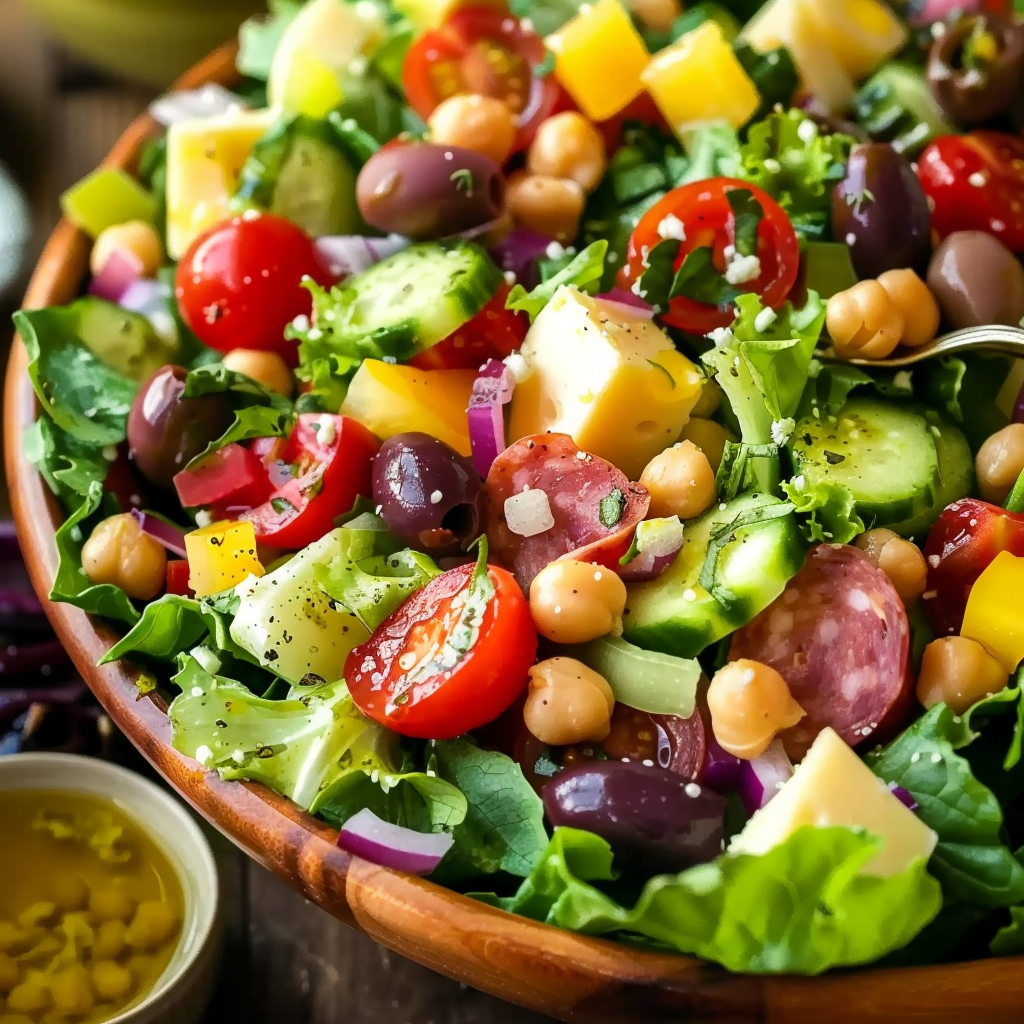
The Homemade Italian Dressing Recipe
A well-crafted Italian chopped salad deserves a bold and zesty dressing, and nothing beats making it from scratch. This homemade Italian dressing enhances every bite with a perfect blend of acidity, herbs, and richness. It’s easy to prepare and significantly healthier than many store-bought versions, which often contain preservatives, added sugar, or excess sodium.
Ingredients You’ll Need
-
⅓ cup olive oil – The foundation of the dressing, rich in healthy fats and flavor. Learn more about its nutritional benefits on Wikipedia’s olive oil page.
-
3 tablespoons red wine vinegar – Brings bright acidity and balances the richness of the oil. Check out red wine vinegar for more on its uses in Mediterranean cooking.
-
1 tablespoon lemon juice – Adds fresh, citrusy zing to cut through salty ingredients like Parmesan and olives.
-
1 teaspoon Dijon mustard – Acts as an emulsifier and brings a subtle tang.
-
1 teaspoon dried oregano – A signature Italian herb that gives this dressing its classic flavor.
-
½ teaspoon garlic powder – Adds depth and savory notes.
-
½ teaspoon salt and ¼ teaspoon black pepper – Essential for seasoning.
How to Make It
-
In a small bowl or jar, combine olive oil, red wine vinegar, and lemon juice.
-
Add Dijon mustard, oregano, garlic powder, salt, and pepper.
-
Whisk vigorously or shake in a sealed jar until fully emulsified.
The result is a dressing that clings to each chopped ingredient without overpowering. The acidity from the vinegar and lemon balances the richness of mozzarella and turkey pepperoni, while the herbs bring the dish together. It’s ideal for meal prep—simply store in an airtight container in the refrigerator for up to a week and shake before using.
If you’re looking for more inspiration, check out Pinterest’s Italian salad dressing recipes for variations using fresh herbs, chili flakes, or even grated cheese blended into the mix.
Pro Tips for Meal Prep and Storage
Keeping your Italian chopped salad fresh and crisp throughout the week is entirely possible with the right prep and storage techniques. These tips will help you enjoy vibrant, crunchy bowls every time.
Salad Prep Tips
-
Use a salad spinner after washing the romaine and other veggies to remove excess moisture. Wet greens can cause the salad to wilt prematurely.
-
Chop ingredients uniformly so they store well and offer even texture in each bite.
-
Layer your salad in meal prep containers: place firmer vegetables like chickpeas and cucumbers at the bottom and greens at the top.
This layered approach prevents sogginess and makes your salad last longer—just like many Pinterest salad prep boards recommend.
Storing the Dressing
Keep your dressing separate until ready to eat. Store it in small reusable containers or jars, and give it a good shake before pouring. Olive oil may solidify slightly in the fridge; letting it sit at room temperature for a few minutes will bring it back to the right consistency.
Refrigeration Guidelines
-
Undressed salad: Keeps fresh for up to 4 days in airtight containers.
-
Dressed salad: Best enjoyed within 24 hours to preserve the crunch.
-
Dressing: Stores for 5–7 days in the refrigerator.
With this method, you can prep 3–4 portions at once, making weekday lunches easy, healthy, and satisfying. Browse more meal prep salad bowl tips for variety and inspiration.
Serving Ideas and Variations
This Italian chopped salad is as versatile as it is delicious. While it’s flavorful and hearty on its own, there are plenty of ways to customize it for different dietary needs and occasions.
Serve It As…
-
Main Course: Add a protein like grilled chicken, shrimp, tofu, or hard-boiled eggs.
-
Side Salad: Serve alongside pasta dishes, pizza, or grilled meats for an Italian-style meal.
-
Wrap or Pita Filling: Spoon the salad into a whole wheat wrap or pita for a handheld option.
Delicious Add-In Variations
-
Keto-friendly: Skip the chickpeas and carrots; increase protein and cheese.
-
Vegan version: Omit mozzarella, Parmesan, and meat—add avocado or vegan cheese alternatives.
-
Gluten-free: Naturally gluten-free—just ensure store-bought items like mustard or deli meats are certified gluten-free.
Looking for more meal inspiration? Check out Pinterest boards on Mediterranean diet salads to try different ingredient pairings that still honor the Italian flavor profile.
By mixing and matching ingredients while keeping the core structure intact, you can make this salad feel new every time you serve it.
Nutrition and Health Benefits
This Italian chopped salad is as healthy as it is delicious, offering a well-rounded mix of macros and micronutrients in every bowl. Whether you’re eating it as a light meal or a side, it’s packed with ingredients that support overall health.
Nutritional Highlights
-
High in fiber: Thanks to romaine, chickpeas, and vegetables, this salad supports digestion and helps with satiety.
-
Protein-rich: Including cheese, chickpeas, or optional meats helps build muscle and sustain energy.
-
Healthy fats: Provided by olive oil and cheese, these fats aid in vitamin absorption and promote heart health.
-
Low in sugar: With no added sugars, it’s ideal for those managing blood sugar levels.
For example, the use of olive oil aligns with the principles of the Mediterranean diet, which emphasizes heart-healthy fats. Similarly, chickpeas are a low-glycemic, plant-based protein source that adds bulk and balance.
A typical serving of this salad (without added meat) is around 300–400 calories, making it a satisfying lunch or dinner. Adjust portions and toppings based on your nutritional goals, such as increasing protein for muscle gain or reducing cheese for lower fat intake.
This is a salad that supports both flavor and function—offering vibrant colors, bold tastes, and the nourishment your body needs.
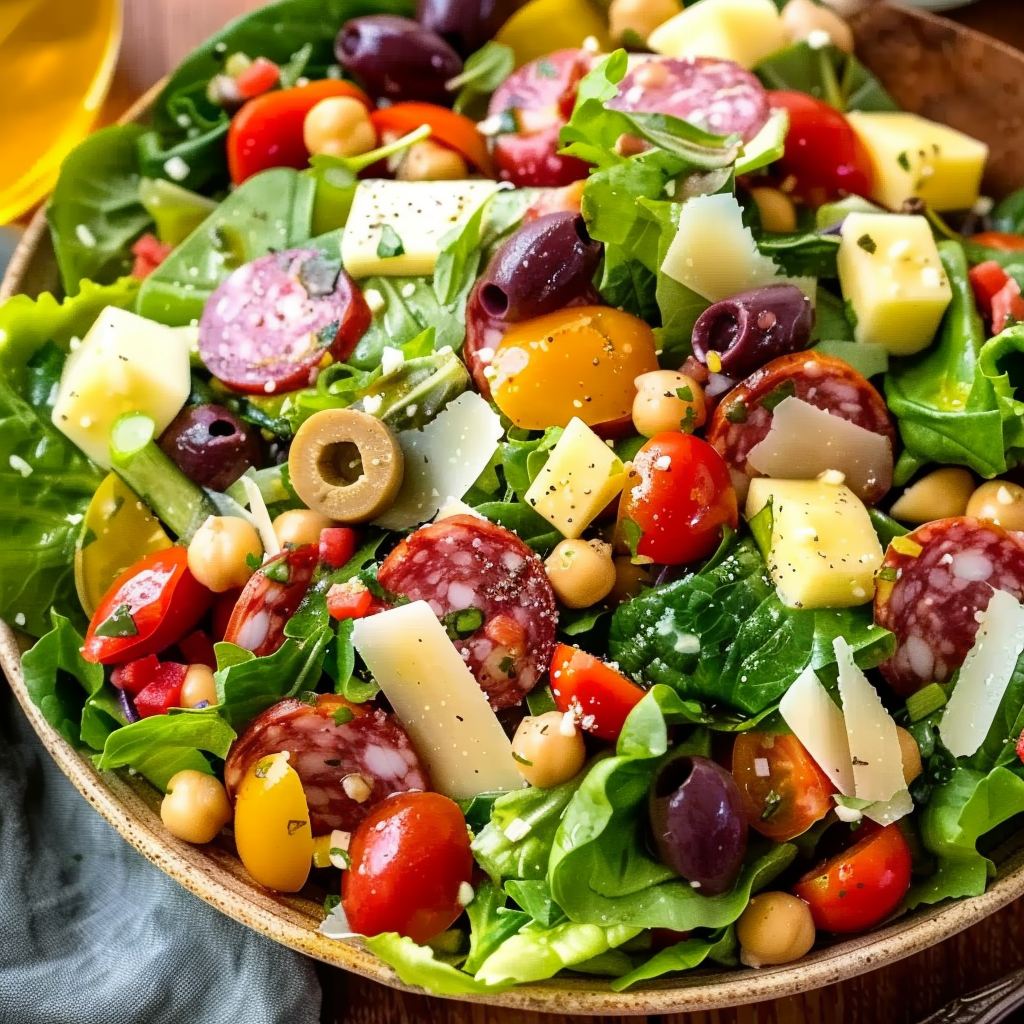
Frequently Asked Questions (FAQs)
What is the difference between a chopped salad and a regular salad?
A chopped salad involves cutting all ingredients into bite-sized pieces, ensuring every bite includes a mix of flavors and textures. Regular salads often layer or toss ingredients in larger portions, which can make each bite less uniform.
Can I make Italian chopped salad ahead of time?
Yes! It’s ideal for meal prep. Store components separately and dress right before serving. This keeps the romaine lettuce and other vegetables from becoming soggy.
What kind of lettuce is best for chopped salad?
Romaine lettuce is the best option due to its crunch, durability, and neutral flavor. It holds up well with heavier ingredients and dressings, unlike softer lettuces.
Is Italian dressing healthy?
Homemade Italian dressing made with olive oil, vinegar, and herbs is generally healthy and rich in monounsaturated fats. Avoid store-bought versions with added sugars or preservatives. For healthier versions, explore homemade Italian salad dressing ideas.
How long can chopped salad last in the fridge?
An undressed chopped salad can last 3–4 days when stored in an airtight container. Keep dressing separate and mix only when ready to eat for the best texture.
Can I use store-bought dressing?
Yes, but homemade is recommended for better flavor and control over ingredients. If using store-bought, opt for one with clean ingredients and low added sugar.
Romaine Lettuce Salad Italian Chopped Guide for Fresh Crunch
This Italian chopped salad with romaine is a fresh, crunchy, and colorful bowl loaded with vegetables, cheeses, and optional protein. It’s tossed in a zesty homemade dressing made from olive oil, red wine vinegar, and herbs. Perfect for meal prep or a quick lunch, this salad delivers bold Italian flavors in every bite.
- Author: Clara
Ingredients
For the salad:
- 4 cups chopped romaine lettuce
- 2 cups chopped radicchio or red cabbage
- 1 cup cherry tomatoes, halved
- 1 cup canned chickpeas, rinsed and drained
- ½ cup chopped cucumber
- ½ cup shredded carrots
- ¼ cup sliced red onion
- ½ cup sliced black or green olives
- ½ cup chopped roasted red peppers
- ½ cup shredded mozzarella cheese
- ¼ cup grated Parmesan cheese
- ½ cup diced chicken ham or turkey pepperoni (optional, as a meat substitute)
For the dressing:
- ⅓ cup olive oil
- 3 tbsp red wine vinegar
- 1 tbsp lemon juice
- 1 tsp Dijon mustard
- 1 tsp dried oregano
- ½ tsp garlic powder
- ½ tsp salt
- ¼ tsp black pepper
Instructions
In a large mixing bowl, combine the romaine, radicchio, cherry tomatoes, chickpeas, cucumber, carrots, red onion, olives, roasted red peppers, mozzarella, Parmesan, and diced chicken ham or turkey pepperoni if using.
In a separate small bowl or jar, whisk together olive oil, red wine vinegar, lemon juice, Dijon mustard, oregano, garlic powder, salt, and black pepper until well combined.
Pour the dressing over the salad and toss until everything is evenly coated.
Serve immediately or chill for 15–30 minutes before serving for best flavor.
Notes
-
Use a sharp knife or salad chopper for even cuts—uniform pieces improve both texture and presentation.
-
Prep in batches: Store undressed salad in separate containers and keep dressing in a jar for easy grab-and-go lunches.
-
Make it vegetarian or vegan by omitting meats and using dairy-free cheeses.
-
Add crunch with sunflower seeds or croutons just before serving.
-
Double the dressing to have extra on hand—it pairs well with pasta salad or grilled veggies.
-
Great for parties: Serve in a large bowl and let guests add dressing and toppings to customize their own servings.
